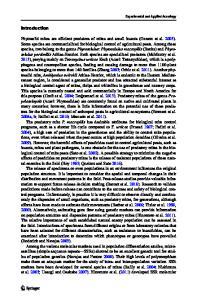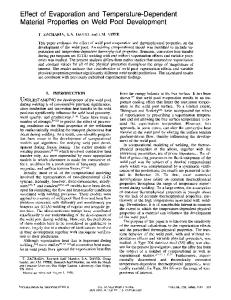Effect of temperature on the development and predatory potential of Exochomus nigripennis (Erichson) (Col.: Coccinellida
- PDF / 306,480 Bytes
- 6 Pages / 595.276 x 790.866 pts Page_size
- 79 Downloads / 303 Views
ORIGINAL RESEARCH ARTICLE
Effect of temperature on the development and predatory potential of Exochomus nigripennis (Erichson) (Col.: Coccinellidae) fed on Gossyparia spuria (Modeer) (Hem.: Eriococcidae) Hamed Rounagh-Ardakani 1 & Mohammad Amin Samih 2 & Soltan Ravan 1 & Azizollah Mokhtari 1 Received: 20 September 2019 / Accepted: 5 February 2020 # African Association of Insect Scientists 2020
Abstract In this study, the effect of four temperatures (23,27, 31, and 35 °C) were evaluated on the development and predatory potential of Exochomus nigripennis (Erichson) (Col.: Coccinellidae) fed on Gossyparia spuria (Modeer) (Hem.: Eriococcidae) under laboratory conditions (60 ± 5% RH, and a photoperiod of 16:8 (L:D) h). The longest developmental time of total immature stages was at 23 °C (49.0 days) and the shortest was at 35 °C (22.5 days). Also, the mortality of immature stages significantly decreased as the temperature was increased from 23 to 31 °C, and then increased at 35 °C. The larvae reared at 31 and 35 °C consumed more prey than those reared at the other rearing temperatures. In contrast, larvae reared at 23 °C ate less prey than those reared at the others. Adults who came from larvae reared at 31 °C were heavier than those reared at the other temperatures. Based on the linear model, the low-temperature threshold for egg incubation, total larval stage and pupal stage was 10.54, 13.91 and 8.34 °C, respectively. In this model, the amounts of thermal requirement for egg incubation, total larval stage and pupal stage was 90.09, 270.27 and 101.01 °C, respectively. The nonlinear estimates were higher than the linear estimates. Overall, the results of the development of immature stages together to the predation rate and the adult weight would have led to the conclusion that 31 °C was favorable to E. nigripennis. Also, our findings support this hypothesis that the development of ectothermic animals like insects is closely linked to environmental temperature. Keywords Adult’s weight . Linear model . Ikemoto and Takai model . The European elm scale . Ladybird
Introduction The European elm scale, Gossyparia spuria (Modeer) (Hem.: Eriococcidae), is an increasingly important pest of ornamental elms (Ulmus spp.) (Ulmaceae) in the Holarctic region, across Europe, Asia and North America (Japoshvili and Kaydan 2018). This pest is present in different parts of Iran, especially in the central areas (Jalalizand et al. 2011). Large populations of G. spuria distort, stunt, and may even kill young trees by direct feeding action and indirectly through honeydew production (Dziedzicka 1961; Kozar et al. 2013). The use of
* Hamed Rounagh-Ardakani [email protected] 1
Department of Plant Protection, Faculty of Agriculture, Zabol University, Zabol, Iran
2
Department of Plant Protection, Faculty of Agriculture, Vali-e-Asr University of Rafsanjan, Rafsanjan, Iran
Coccinellidae predators (Coleoptera) has yielded satisfactory results in numerous examples of biological control of sucking pests such as Exochomus nigripennis (Erichson) (
Data Loading...











